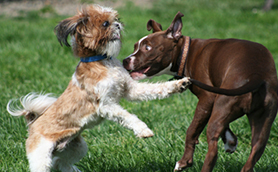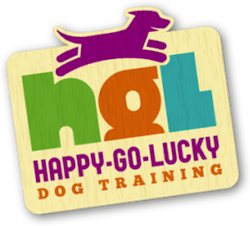 Managing and training your dog can help prevent inappropriate play which can escalate into aggression.
Managing and training your dog can help prevent inappropriate play which can escalate into aggression.
PLAYING WITH YOU
Puppies first learn to play with their littermates. Their play consists of a lot of rough-and-tumble activity and tons of play biting. A dog playing in this fashion with an adult or child can be potentially dangerous. It is our responsibility to teach our dogs appropriate games they which can play with us.
SOME INTERACTIVE GAME IDEAS:
- Fetch
- Hide and Seek: Hide from your dog while talking excitedly to him. When he finds you, have a big party!
- Find It: Hide a treat/toy from your dog. Say “find it!” and help your dog locate the treat. Help your dog less as he starts to understand the game.
- Catch Me if You Can: Run away from your dog. When he catches up to you, reward him.
- Tug-of-War: Tell your dog “take it,” begin the tuggin’ fun, then tell your dog “drop”.
- Wild Dog: Get your dog wound up and then throw in an obedience command. If your dog succeeds, resume the wild play again.
*Note-if your dog gets too rough or his teeth touch you during play, say “OW!” and stop all play. Wait a few seconds for your dog to calm down, then resume the game.
PLAYING WITH OTHER DOGS
Dogs need to continue their interactions with one another throughout their lives to keep them socially savvy. They rely on us to match them up with appropriate playmates. In addition, close supervision is key when dogs are meeting new canine buddies. Excited and rough play can spiral out of control and cause tempers to flare. Adolescent dogs need even closer supervision.
IN APPROPRIATE DOG PLAY YOU WILL SEE:
- play bows (front elbows down and butt in the air)
- loose, relaxed bodies
- inhibited biting
- racing around and/or wrestling
- turn taking (one dog’s on top and then the other’s on top)
- occasional yelps and reprimands
- all dogs having a good time
GREETING OTHER DOGS
When first meeting another dog (that you’ve been assured is friendly!), start in a neutral territory. Make sure your dog’s approach exhibits appropriate body language. It sends the wrong message if your dog leans into the leash with all his weight and barges straight in. Polite dogs approach in a curve, usually doing some nose/head sniffs before going to the other dog’s rear. Have your dog focus on you before you approach. And once you get there, be cheerful and move about loosely. Chat a little to the dogs.
Watch for any stiffness, breath holding, whites of the eyes showing or faces wrinkling up. As soon as you see this, calmly call each dog to its owner to stop the interaction. The first greeting should be short. Each time the dogs are relaxed in each other’s presence, let them play longer. When you are comfortable, drop their leashes and let them drag them while playing, making sure they don’t get tangled up. When you’re ready, go ahead and take the leashes off but keep supervising. Remember to be relaxed and move around the area the dogs are playing in. Move if the dogs get pushed up against your legs while they play.
SIGNS OF TROUBLE:
- a frightened dog running away/trying to hide from another dog
- a dog standing over another dog for a prolonged period
- continued/excessive yelping
- continued mounting or paws up on another dog’s shoulders
- a dog standing on hind legs for too long
- bodies stiff/tense
- hard staring
- escalating growls
- a cornered dog snapping
- a dog getting too wound up
Intervene at the first sign of trouble and redirect your dog (off, leave it, come, etc.). If necessary, quickly time-out your dog. Dogs, just like children, should not be allowed to just “work it out.” Monitor and manage their interactions so your dog stays safe and does not develop any inappropriate behaviors.


